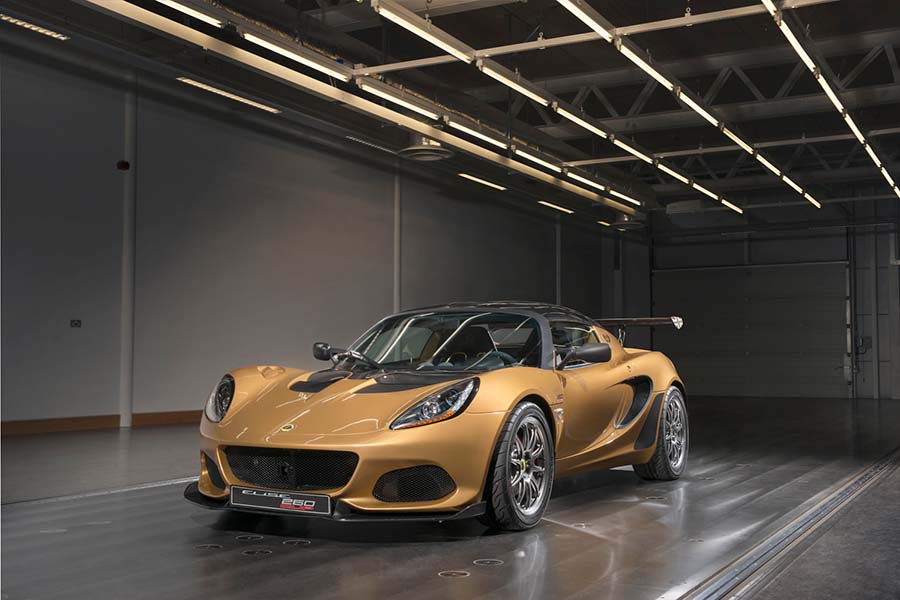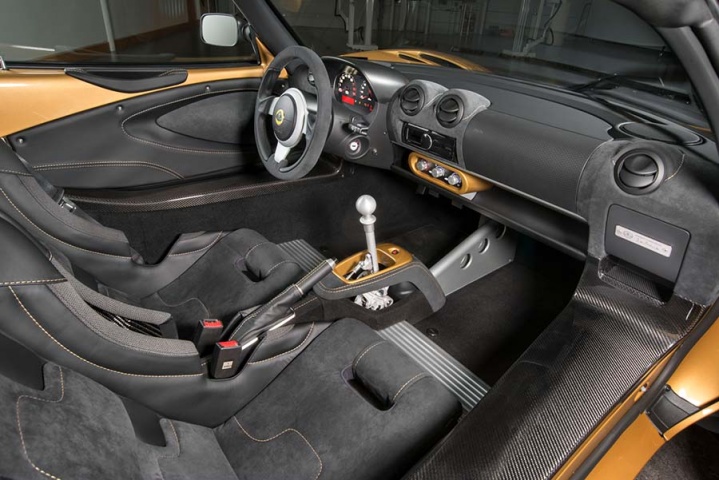What's the news?
Lotus has built the fastest road-going version of its venerable Elise yet, which is called the Cup 260. This will be a super-rare example of the Norfolk-produced sports car, as just 30 examples will be made in total.
Building on last year's extreme Cup 250, but using the facelifted bodywork and revised, better-equipped interior of the Elise that we saw on this year's Sprint 220, the Cup 260 is launched in preparation for the 70th anniversary of Lotus founder Colin Chapman's first production car, bolted together in 1948. It therefore has a laurel wreath decal on the left buttress - to mark Lotus' motorsport successes - and can be finished in iconic Championship Gold.
Lighter in build than the Cup 250, heavier at speed thanks to increased downforce and boasting another 7hp/5Nm from its supercharged 1.8-litre, four-cylinder petrol engine, the Cup 260 is a tenth of a second quicker from 0-100km/h than the 250 at 4.2 seconds, although it loses a little top speed (243- plays 248km/h). Nevertheless, the Cup 260 is fully 2.5 seconds faster than the Cup 250 around Lotus' own fabled Hethel test track, setting a scorching 1m 32s lap time. Thank learnings from the competition-only Elise Race 250 for that.
So, a few more details. The Cup 260 can generate fully 180kg of downforce at its maximum velocity, when the Cup 250 summoned up 155kg at 248km/h. That increase comes courtesy of louvred front wheel-arch vents, a lightweight carbon fibre front splitter, the rear diffuser and the wide, high-mounted rear wing developed from the 3-Eleven.
And in terms of weight, the Cup 260 is 862kg in its lightest possible dry configuration, or 902kg unladen; Lotus says this is 15kg lighter than the Cup 250, although that car was said to weigh in at 921kg with its optional Carbon Aero Pack... and our maths makes that 19kg. Anyway, lightweight carbon fibre and composite materials are used for the sill covers (saving 0.8kg), roll hoop cover (-0.7kg), front access panel (-1.1kg) and engine cover (-3.3kg), to the lightweight two-piece brake discs (-4kg) - and there's a polycarbonate rear screen, too, lifted from the Cup 250. All this, on top of other standard Cup 250 items, such as the carbon seats (weighing just 6kg each) and a lithium-ion battery (saving 9kg).
Power takes a modest hike of 7hp to 253hp overall, while torque is up 5Nm to 255Nm as a result of new induction components and revised calibration. The uprated 1.8-litre engine drives the rear wheels through a six-speed, close-ratio manual gearbox, with the power-to-weight ratio now up to 290hp-per-tonne, some way up on the Cup 250's already-impressive 267hp-per-tonne. Emissions stand at 175g/km CO2 and 37.7mpg (7.5 litres/100km), the same as they were previously.
Finally, Lotus Motorsport has had a go at the chassis and fitted two-way adjustable Nitron dampers, featuring 24 settings for rebound and compression, for the first time to an Elise. Lightweight 16-inch front, 17-inch rear forged alloys are wrapped in Yokohama Advan Neova AD08R tyres, which are 10mm wider on both axles than the rubber on the Cup 250. Braking is provided by AP Racing twin-piston front callipers and Brembos at the rear.
Not much else to report from there; the interior is hand-trimmed and now features that exquisite open-gate mechanism as seen on the Sprint 220, while the seats come in black Alcantara with red or yellow contrast stitching. Much of the new technology additions and detail points of the revised cabin of that Sprint 220 can be found here.
Anything else?
Jean-Marc Gales, Lotus' CEO, said: "As we near the 70th anniversary of the inception of Colin Chapman's engineering legacy, it's only right that we build the very best cars as special editions, and the Elise Cup 260 is certainly worthy of that accolade. Our special editions have always proved extremely popular with our customers around the world, and we know they value the extensive development work that goes into each one. With just 30 examples to be built, there's no doubt that the Elise Cup 260 is a future classic."
And Clive Chapman, son of Lotus founder Colin and also director of Classic Team Lotus, added: "Each and every one of the sports cars produced by Group Lotus today carries the true spirit of Lotus, laid down by my father nearly 70 years ago. I am extremely proud that his legacy and achievements are being acknowledged and celebrated in this iconic version of the Elise."
To find out more about Lotus Elise Cup 260, visit the Lotus website.




